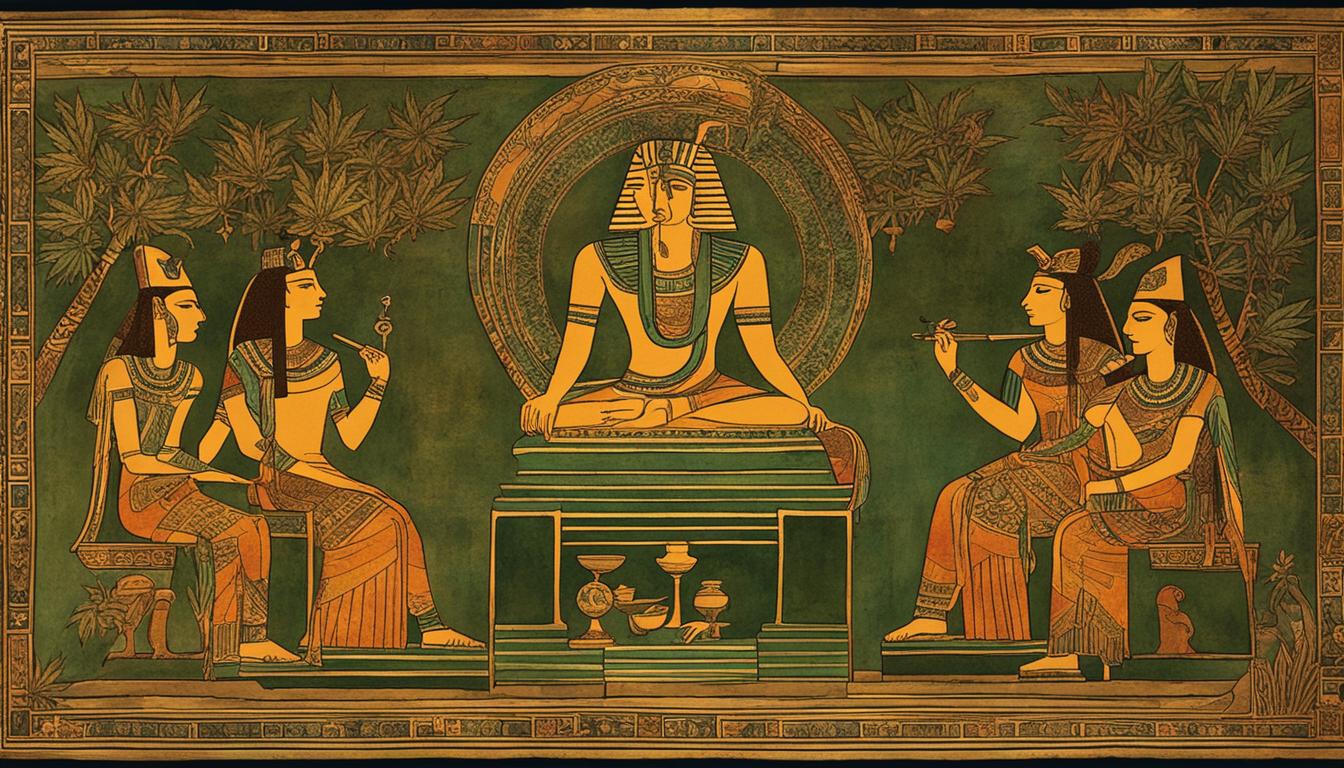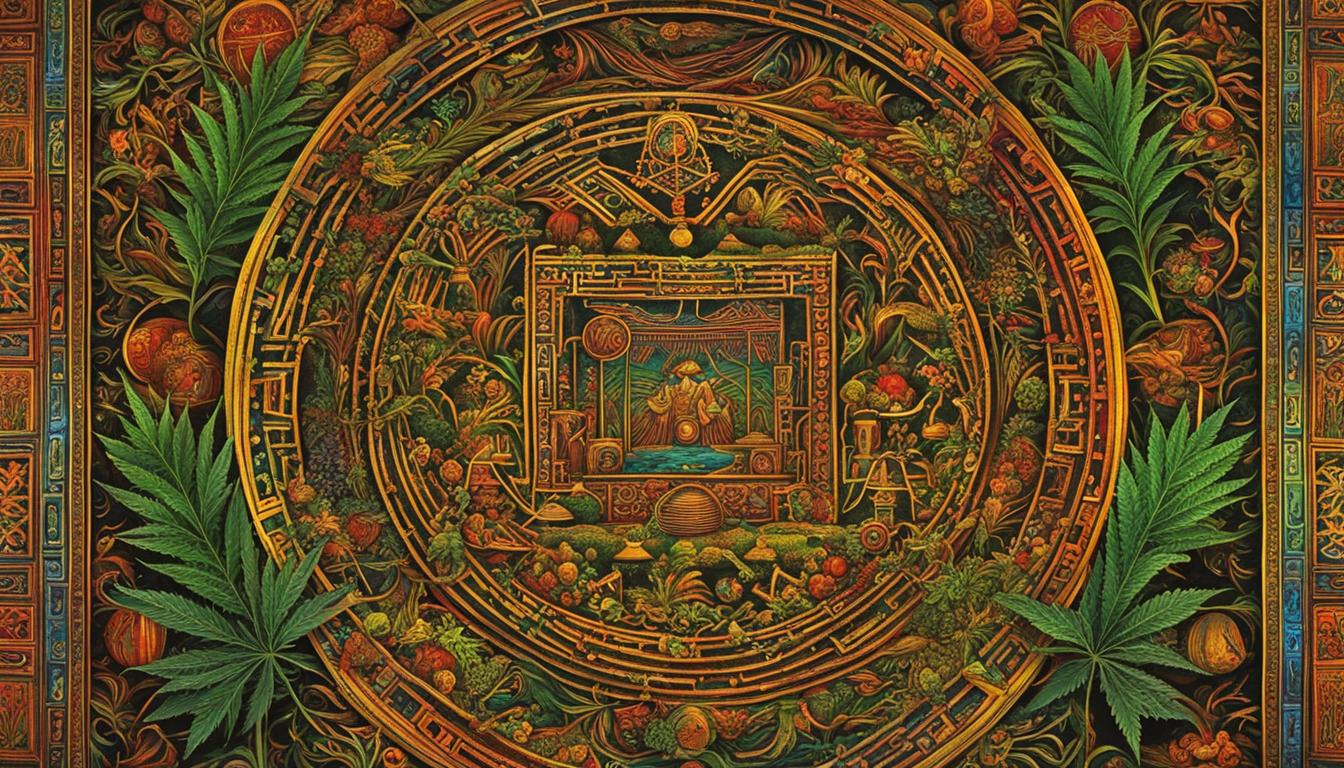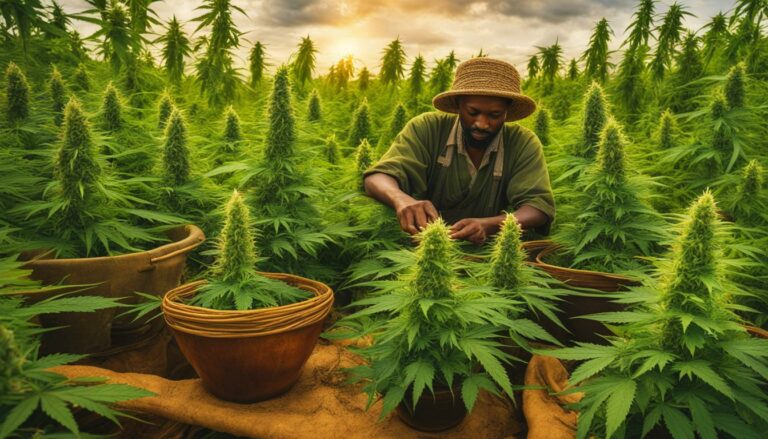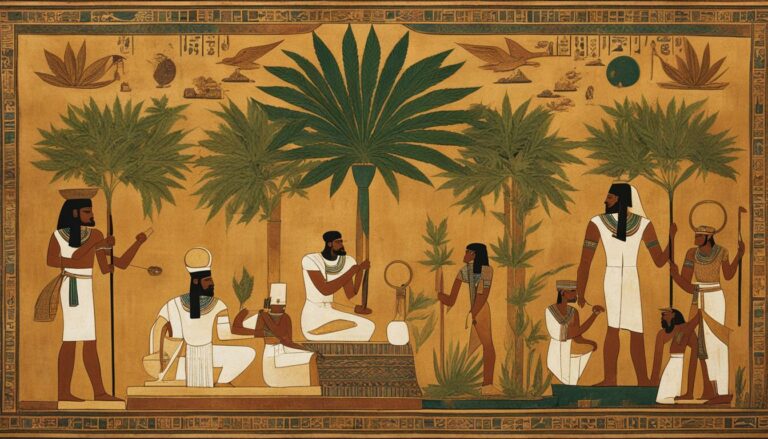The Silk Road: How Cannabis Travelled Across Continents
Welcome to a world where history and adventure intertwine, where cultures collide, and where a humble plant has left an indelible mark on the human journey. Join us as we embark on a captivating exploration of the Silk Road, where cannabis traversed vast landscapes, connecting East and West in a tapestry of trade, discovery, and cultural exchange.
At the heart of this ancient network of trade routes lies the story of cannabis, a plant that originated in Central Asia and found its way to every corner of the globe. As we traverse the path of this remarkable journey, we will uncover the historical significance of cannabis, its impact on civilizations past and present, and the emergence of cannabis tourism as a thrilling trend for modern-day travelers.
Step into the world of cannabis-friendly destinations, where the allure of the Silk Road beckons. From hidden gems along the route to well-known cannabis hotspots, the landscape is as diverse as the plant itself. Experience the unique cannabis cultures, indulge in exquisite cannabis-infused cuisines, and immerse yourself in the vibrant tapestry of traditions surrounding this extraordinary plant.
So come, fellow adventurer, and let us unlock the secrets of the Silk Road, where cannabis has woven its way through the annals of history and continues to shape our world today.
The Origins of Cannabis
Explore the fascinating history of cannabis, a plant with deep roots that have intertwined with human civilization for centuries. From its origins in Central Asia to its widespread use across ancient civilizations, the story of cannabis is one of migration, trade, and cultural exchange.
Ancient cannabis use can be traced back thousands of years, with evidence of its consumption and cultivation found in various regions. Civilizations such as the Scythians, Chinese, Indians, and Egyptians were among the early adopters of cannabis, utilizing it for medicine, fiber production, and spiritual ceremonies.
Through the migration patterns, conquests, and trade routes of different civilizations, cannabis traveled across continents, leaving its mark on cultures around the world. The plant’s versatility and significance in ancient times set the stage for its continued exploration and innovation in modern times.
Ancient Cannabis Use
Ancient civilizations recognized the diverse uses and potential benefits of cannabis. In the Czech Republic, archaeological evidence dating back to 2900 BC shows the earliest documented use of cannabis. This discovery suggests that cannabis has been part of human culture for thousands of years, spanning continents and shaping the development of societies.
“The migration patterns, conquests, and trade routes of different civilizations were intertwined with the spread of cannabis.”
A Global Journey
As cannabis traveled across the Silk Road, it found its way into the hands of different cultures, leaving behind a rich tapestry of customs and traditions. From the Scythians who introduced cannabis to Iran, Anatolia, Greece, Egypt, and Africa, to the Greeks who used it for various purposes, the plant became a valuable commodity and a symbol of cultural exchange.
| Region | Ancient Use of Cannabis |
|---|---|
| Central Asia | Origin of cannabis |
| Egypt | Found in Egyptian mummies |
| Greece | Used in rituals and medicine |
| Rome | Utilized for fiber production |
Cannabis has continued to intrigue and captivate cultures throughout history. Today, as societies reevaluate their perceptions and legalize the use of cannabis, we embark on a new chapter in the journey of this remarkable plant.
Cannabis on the Silk Road
The Silk Road, the ancient network of trade routes connecting the East and West, not only facilitated the exchange of goods but also played a significant role in the spread of cannabis. As the Silk Road began to take shape, cannabis quickly became an important commodity along the trade routes. The Scythians, nomadic Indo-Europeans, cultivated cannabis for rituals and burial customs, introducing the plant to Iran, Anatolia, Greece, Egypt, and Africa.

Greek historian Herodotus documented the use of cannabis by the Scythians in social rituals, and evidence of cannabis has been found in Egyptian mummies and the tomb of Ramses II. Cannabis also spread to Greece, where it was used for various purposes, and later reached Spain and Morocco through the Moorish invasion.
| Scythians and Cannabis | Cannabis in Greece and Egypt |
|---|---|
| Scythians cultivated cannabis for rituals and burial customs | Evidence of cannabis found in Egyptian mummies and Ramses II’s tomb |
| Introduced cannabis to Iran, Anatolia, Greece, Egypt, and Africa | Cannabis used for various purposes in Greece |
The Cultural Impact
The introduction of cannabis along the Silk Road had a profound cultural impact on the regions it reached. It became integrated into rituals, social customs, and even played a role in burial practices. The use of cannabis by the Scythians and its adoption by other civilizations along the Silk Road highlights the plant’s significance as a cultural symbol and its ability to transcend geographical boundaries.
Cannabis in Asia and Africa
Cannabis has had a significant presence in Asia and Africa, where it has been deeply woven into the fabric of cultures and traditions. In India, cannabis holds a long-standing history, being used for centuries in various religious and spiritual practices. One notable example is the consumption of “bhang,” a cannabis-infused drink, during festivals and celebrations. This ancient tradition continues to thrive, with cannabis playing a pivotal role in enhancing spiritual experiences and fostering a sense of unity among participants.
In Ethiopia, cannabis has also been embraced by indigenous tribes for its medicinal and spiritual properties. It is believed that cannabis was introduced to Ethiopia through trade, and it has since become an integral part of traditional healing practices. The plant is used in rituals, ceremonies, and as a natural remedy for various ailments. The cultural significance of cannabis in Ethiopia demonstrates the enduring connection between the plant and the people.
“Our ancestors used cannabis as a sacred herb, believing in its ability to heal and connect us to the spirit world. It continues to be an essential part of our cultural heritage.” – Elder from an Ethiopian tribe.
In Africa, cannabis has also played a role in the spiritual and medicinal practices of native tribes in the Congo and the Ituri rainforest. These tribes have a deep understanding of the plant’s therapeutic properties and incorporate it into their rituals and healing ceremonies. Cannabis has become a symbol of unity, healing, and cultural identity within these communities.
The cultural significance of cannabis in Asia and Africa highlights the profound connection between humans and the plant, transcending time and borders. These regions continue to cherish and celebrate the diverse uses and spiritual associations of cannabis, preserving their unique cultural heritage for future generations.
Cannabis in Greco-Roman Cultures
The Greco-Roman cultures have a rich history intertwined with the use of cannabis. This remarkable plant played a significant role in these ancient societies, not only as a source of fiber but also as an intoxicant. Cannabis was highly valued for its versatile properties and was utilized in various aspects of life.
In Greek and Roman civilizations, cannabis was extensively used for making rope, sails, and canvas due to its strong and durable fibers. The plant’s fibers were an essential resource for seafaring nations, enabling the construction of ships that facilitated trade and exploration. Its widespread cultivation and utilization in these maritime societies highlight the integral role it played in their economic and cultural development.
Moreover, evidence of cannabis’s presence in these cultures can be found in the ruins of Pompeii, the ancient Roman city buried by the eruption of Mount Vesuvius. Cannabis seeds, among other plant remains, were discovered, shedding light on its consumption and cultivation in this prosperous city. The findings provide valuable insights into the daily lives and consumption habits of the Greco-Roman people.
The integration of cannabis into the Greco-Roman cultures demonstrates its enduring cultural significance and its ability to shape the practices and traditions of ancient civilizations.
Overall, cannabis had a profound impact on the Greco-Roman cultures, serving as a vital resource and a symbol of cultural heritage. Its versatile applications and historical significance continue to fascinate researchers and enthusiasts alike, highlighting its enduring influence on human civilization.
Cannabis in Modern Times
In the contemporary cannabis industry, the increasing potency of cannabis has been a significant trend. Through advancements in cultivation techniques, strains and products are now reaching higher levels of THC concentration than ever before. This rise in potency has contributed to the popularity of cannabis among recreational users seeking a more intense experience. Additionally, the legalization of cannabis in various countries has opened up new markets and opportunities for businesses in the industry.
The cannabis market offers a wide range of products to cater to different consumer preferences. From traditional forms such as pre-rolled joints to innovative options like edibles, vaporizers, and oils, there is something for everyone. This diversity in product offerings has allowed cannabis to transcend its traditional image and appeal to individuals from all walks of life. Whether it’s for relaxation, pain management, or simply exploring new experiences, the modern cannabis market provides a multitude of options.
As the cannabis industry continues to evolve, research and technology are playing crucial roles in shaping its future. Scientists are studying the potential health benefits of different cannabinoids, including CBD, and exploring their uses in treating various conditions. This research is paving the way for new breakthroughs and innovations in cannabis-based therapies. Simultaneously, cultural perceptions and attitudes towards cannabis are also changing, with a growing acceptance and recognition of its potential positive impact on wellbeing.
Overall, the contemporary cannabis industry is a dynamic and rapidly developing space. With increasing potency, diverse product offerings, and ongoing research, cannabis continues to captivate the interest of consumers and researchers alike. As societal attitudes towards cannabis continue to shift, it is essential to keep an eye on the evolving landscape and stay informed about the latest developments in this exciting field.
The Rising Potency of Cannabis
“The increasing potency of cannabis has created a demand for more potent strains among recreational users, who are seeking a more intense and potent experience.”
Cannabis and Health Claims
Cannabis, with its numerous active cannabinoids, has been at the center of health claims and research exploring its potential benefits. One of the most well-known cannabinoids is CBD (cannabidiol), which has gained popularity for its possible therapeutic properties without the psychoactive effects of THC (tetrahydrocannabinol). CBD is believed to have potential anti-inflammatory, analgesic, and anxiolytic properties, making it a sought-after component in various health and wellness products.
While research on cannabis and its cannabinoids is ongoing, studies have shown promise in the areas of pain management, epilepsy, anxiety disorders, and sleep disorders. For example, CBD has been found to be effective in reducing seizures in certain types of epilepsy, leading to the development of FDA-approved medications. Additionally, CBD’s potential anti-inflammatory properties have sparked interest in its use for conditions such as arthritis and multiple sclerosis.
However, it is essential to note that the health claims surrounding cannabis and its cannabinoids are still being evaluated, and further research is needed to fully understand their effects on specific conditions and individuals. The complex nature of cannabis compounds and the wide range of factors that influence their efficacy make it important to approach health claims with caution. Consulting healthcare professionals and conducting thorough research are crucial for individuals considering cannabis-based treatments.
“CBD has shown potential in managing a variety of conditions, but more research is needed to fully understand its effects and ensure safe and effective usage.”
The Benefits of Cannabinoids
Research into cannabinoids like THC and CBD is shedding light on their potential therapeutic benefits. While THC is best known for its psychoactive effects, it also exhibits properties that may be beneficial for certain medical conditions. For instance, THC has been used in the treatment of nausea and vomiting associated with chemotherapy, as well as appetite stimulation in patients with wasting syndrome.
Moreover, cannabinoids have been found to interact with the body’s endocannabinoid system, which plays a role in regulating various physiological processes such as pain perception, mood, and immune function. This interaction has led to investigations into the potential use of cannabinoids in managing chronic pain, mental health conditions, and autoimmune disorders.
| Cannabinoid | Potential Benefits |
|---|---|
| THC | Pain relief, appetite stimulation, nausea reduction |
| CBD | Anti-inflammatory, analgesic, anxiolytic properties |
| CBG | Antibacterial, anti-inflammatory properties |
It is important to remember that while cannabinoids hold promise in the field of medicine, further research is needed to fully understand their benefits and potential risks. Cannabis products should be used responsibly and under the guidance of healthcare professionals.
Cultural Significance of Cannabis
Cannabis holds a deep-rooted cultural significance in various rituals, festivals, and traditions across the globe. From ancient shamanistic practices to contemporary religious ceremonies, the plant has symbolized spiritual enlightenment and unity among communities. Its integration into cultural festivities fosters social cohesion and celebrates the plant’s role in shaping cultural identities.
Throughout history, cannabis has been revered as a sacred herb with transformative properties. In many indigenous cultures, it is believed to connect individuals with the spiritual realm and enhance their understanding of the world. Cannabis rituals often involve the consumption or burning of the plant, accompanied by prayers, chants, and communal gatherings.
“Cannabis has long been regarded as a sacred plant, connecting us with our ancestors, the natural world, and the divine. Its use in rituals allows us to tap into a higher consciousness and explore the depths of our spiritual selves.” – Shaman Ayahuasca
The cultural significance of cannabis extends beyond its role in spirituality. It has been an integral part of traditional medicine systems in various cultures, with documented uses dating back thousands of years. The plant’s therapeutic properties have been utilized to alleviate physical ailments, promote relaxation, and enhance overall well-being.
| Country/Region | Traditions and Rituals |
|---|---|
| Jamaica | The Rastafarian movement incorporates cannabis as a sacrament in rituals and sees it as a means of spiritual awakening and connection to God. |
| India | Cannabis forms an important part of Hindu religious practices, with devotees using it during certain festivals and rituals to honor Lord Shiva. |
| Morocco | The indigenous population of Morocco, such as the Berbers, have a long history of cannabis use as part of their cultural and spiritual traditions. |
The cultural significance of cannabis not only enriches the lives of individuals but also contributes to the preservation and celebration of diverse cultural heritage. By understanding and appreciating the role of cannabis in rituals and traditions, we gain a deeper appreciation for the plant’s profound impact on human societies throughout history.

Navigating the Modern Cannabis Landscape
The landscape surrounding cannabis is undergoing a profound transformation, with the legalization of cannabis in various countries serving as a catalyst for change. As societies grapple with the stigma surrounding cannabis, a cultural revival of this remarkable plant is taking place. The shift in legislation and evolving cultural perceptions provide opportunities for holistic well-being and a reevaluation of the societal significance of cannabis.
Cannabis legalization represents a paradigm shift, challenging long-held beliefs and prejudices associated with the plant. By embracing legalization, societies are acknowledging the potential benefits of cannabis and recognizing its cultural and historical heritage. This shift enables individuals to explore the diverse experiences and opportunities that cannabis offers, from medicinal applications to spiritual practices.
“The legalization of cannabis is not just about the plant itself; it is about breaking down barriers and fostering a more inclusive society. It is an opportunity to challenge stereotypes and promote a more enlightened perspective on cannabis,” said Dr. Jane Carter, a leading advocate for cannabis legalization.
The cultural revival of cannabis extends beyond legislation. It entails a shift in societal attitudes and a reevaluation of the plant’s potential contributions to various aspects of modern life. As perceptions evolve, individuals and communities are exploring new avenues for cannabis use, from wellness rituals and spiritual ceremonies to creative expressions and social gatherings.
| Perceptions of Cannabis | Before Legalization | After Legalization |
|---|---|---|
| Stigmatized | ✓ | ✗ |
| Illegal | ✓ | ✗ |
| Medicinal Benefits Recognized | ✗ | ✓ |
| Socially Acceptable | ✗ | ✓ |
The changing landscape of cannabis presents an opportunity for individuals to navigate through this transformative journey. By embracing the cultural revival and challenging the stigma surrounding cannabis, people can explore the diverse benefits and experiences associated with this remarkable plant. As society continues to evolve, it is crucial to support comprehensive education and meaningful dialogue to foster a more inclusive and enlightened understanding of cannabis.
Conclusion
The journey of cannabis along the Silk Road has had a profound cultural impact, shaping ancient civilizations, trade routes, and modern industries. From its origins in Central Asia, cannabis has traveled across continents, leaving its mark on diverse cultures and histories.
As the cannabis landscape continues to evolve, embarking on a cannabis journey along the Silk Road allows travelers to explore the rich cultural heritage and diverse experiences associated with this remarkable plant. From cannabis-friendly destinations to unique cannabis experiences, there is much to discover along this historical route.
With the legalization and acceptance of cannabis, it is important to celebrate its cultural significance and navigate the opportunities and challenges it presents. The Silk Road Cannabis Travel offers a chance to connect with the past while embracing the transformative potential that cannabis holds in modern life.
As we reflect on the incredible journey of cannabis, let us appreciate its profound impact on human societies, its role in rituals and traditions, and the ever-evolving cultural revival it brings. The Silk Road Cannabis Travel stands as a testament to the enduring power of this plant and the cultural tapestry it has woven throughout history.
FAQ
What is the Silk Road?
The Silk Road was an ancient network of trade routes that connected the East and West, fostering cultural exchange and the movement of goods, including cannabis.
Where did cannabis originate?
Cannabis, also known as marijuana, originated in Central Asia.
How did cannabis spread throughout the world?
Cannabis quickly spread throughout the world through migration patterns, conquests, and trade routes of different civilizations.
What role did cannabis play on the Silk Road?
Cannabis became an important commodity along the Silk Road trade routes, with its cultivation and use spreading across multiple regions.
Which ancient civilizations were early adopters of cannabis?
Ancient civilizations such as the Scythians, Chinese, Indians, and Egyptians were among the early adopters of cannabis.
What purposes was cannabis used for in ancient civilizations?
Cannabis was used for various purposes, including medicine, fiber production, and spiritual ceremonies.
What evidence exists of ancient cannabis use?
Evidence of ancient cannabis use dates back thousands of years, with the earliest documented uses dating as far back as 2900 BC in the Czech Republic.
How did cannabis travel across continents?
The cultivation and trade of cannabis by the Scythians and other ancient civilizations facilitated its spread across continents, leaving its mark on different cultures.
How did cannabis impact Greco-Roman cultures?
Cannabis played a significant role in Greco-Roman cultures as a source of fiber and an intoxicant, with its versatility and value recognized by these ancient societies.
What is the present-day landscape of the cannabis industry?
The cannabis industry has experienced significant growth and development, particularly since its legalization in various countries, offering a range of cannabis products.
What are the potential health benefits of cannabinoids?
Cannabinoids such as THC and CBD have gained attention for their potential health benefits and have been increasingly used to alleviate various conditions such as pain and anxiety.
How has cannabis been integrated into cultural practices?
Cannabis has had a deep cultural significance in various rituals, festivals, and traditions around the world, symbolizing spiritual enlightenment and unity.
How can society navigate the challenges and opportunities presented by cannabis legalization?
As society navigates the legalization and acceptance of cannabis, it is important to celebrate its diversity, historical heritage, and the transformative potential it offers in various aspects of modern life.
What can travelers expect on a cannabis journey along the Silk Road?
Embarking on a cannabis journey along the Silk Road allows travelers to explore the rich cultural heritage and diverse experiences associated with this remarkable plant.
Source Links
- https://www.cbc.ca/documentaries/the-nature-of-things/weed-is-stronger-than-ever-but-it-might-not-affect-our-brains-that-much-6-surprising-facts-about-cannabis-1.6719799
- https://weedmaps.com/learn/cannabis-and-its-evolution/cannabis-first-use-and-migration
- https://altmed.com.au/cannabis-101/cannabis-history/global-roots-and-impact-a-history-of-cannabis/














